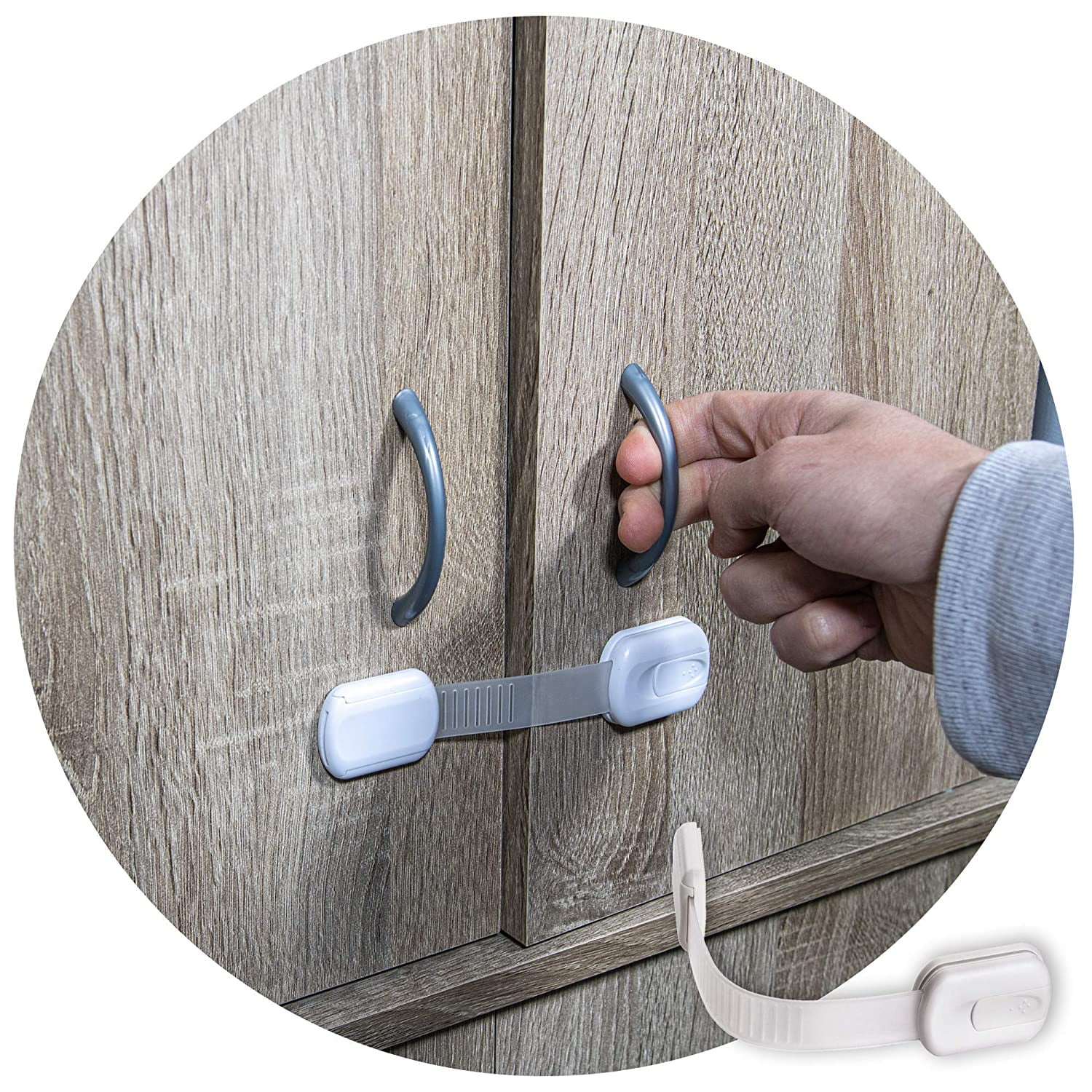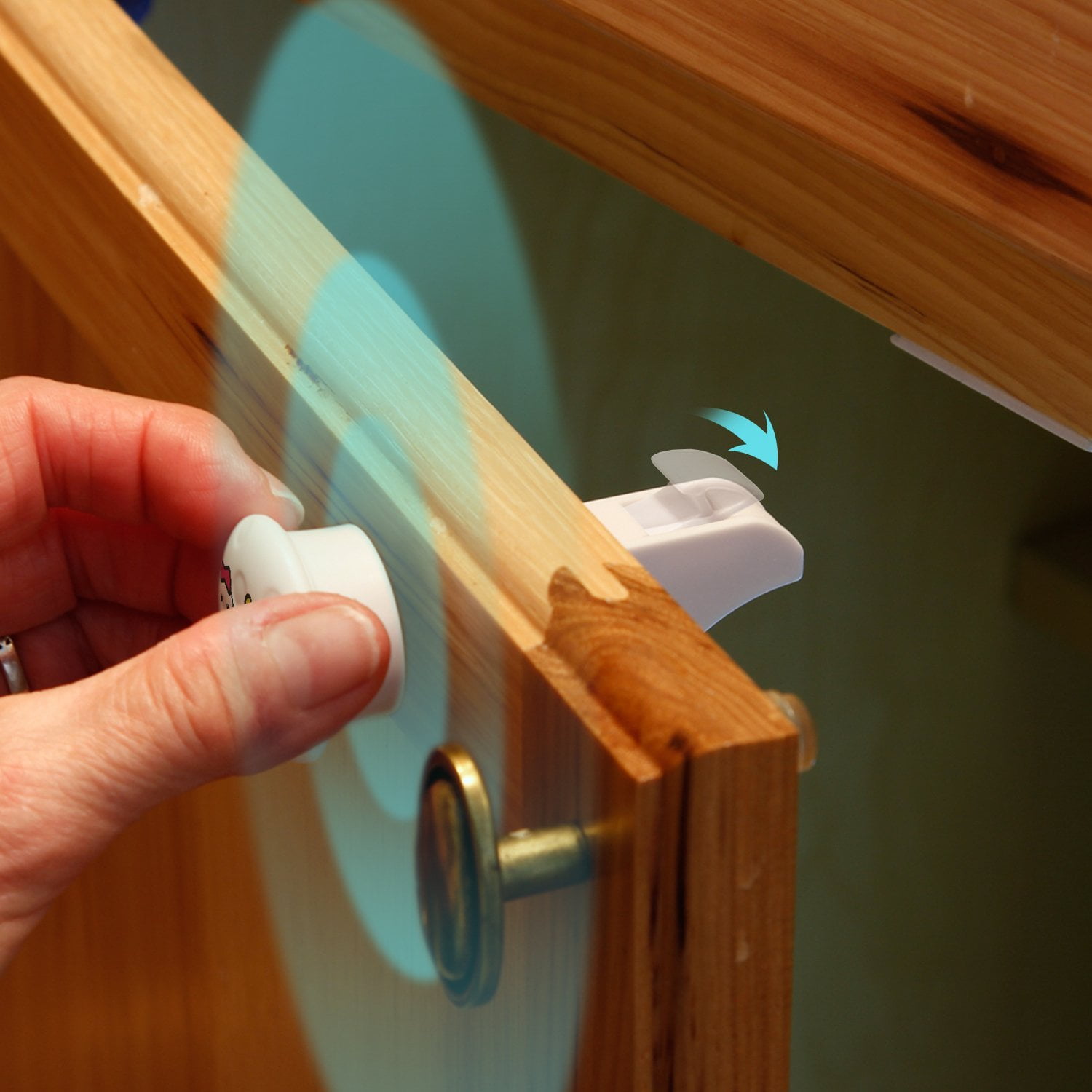Types of Child Locks for Cabinet Doors

Choosing the right child locks for your cabinets is crucial for keeping little ones safe from potential hazards. Different lock types offer varying levels of security, ease of use, and durability. Understanding these differences will help you make an informed decision based on your specific needs and preferences.
Magnetic Child Locks
Magnetic child locks are a popular choice due to their simple design and relatively easy installation. They typically consist of two parts: a magnet that attaches to the inside of the cabinet door and a metal plate that attaches to the cabinet frame. The magnet holds the door closed, preventing children from opening it. Installation usually involves strong adhesive strips or screws. These locks are generally easy to use for adults, but their effectiveness depends on the strength of the magnet and the weight of the cabinet door. A strong magnet will hold heavier doors more effectively. They are relatively inexpensive and readily available. However, determined toddlers might be able to overcome them, especially if the magnet is weak or the adhesive fails.
Push-Button Child Locks
Push-button locks require you to press a button or lever to release the latch. These are often more secure than magnetic locks because they require a deliberate action to open. Installation is usually straightforward, often involving adhesive strips or screws. They are generally user-friendly for adults, offering a simple and intuitive mechanism. The main disadvantage is that some children, particularly older toddlers, might figure out how to manipulate the button. The durability also depends on the quality of the materials used. Cheaper options may break more easily.
Keyed Child Locks
Keyed locks offer the highest level of security. These locks use a key to unlock the cabinet, making them virtually impossible for young children to open. Installation can be more complex than other types, often requiring drilling and screwing. While they provide excellent protection, they are less convenient for adults as you always need the key. Losing the key is a significant drawback, and replacing them can be costly. They are typically more expensive than magnetic or push-button locks.
Combination Child Locks
Combination locks use a dial or keypad to open, offering a balance between security and convenience. They don’t require keys, and the combination can be changed. Installation methods vary depending on the design, often involving adhesive or screws. They are generally user-friendly but may require some teaching for adults to remember the combination. The level of security depends on the complexity of the combination and the quality of the lock mechanism. They are usually more expensive than basic magnetic or push-button locks.
Comparison Table
| Mechanism Type | Installation Difficulty | Price Range (IDR) | User Reviews (Summary) |
|---|---|---|---|
| Magnetic | Easy | 10,000 – 50,000 | Easy to install, but may not be effective for determined toddlers. |
| Push-Button | Easy to Moderate | 20,000 – 75,000 | More secure than magnetic, but some children may still be able to open them. |
| Keyed | Moderate to Difficult | 50,000 – 150,000 | Very secure, but inconvenient due to key requirement. |
| Combination | Easy to Moderate | 60,000 – 120,000 | Good balance between security and convenience, but combination needs to be remembered. |
Installation and Usage of Child Locks

Installing child locks on your cabinets might seem like a small task, but it’s a crucial step in keeping your little explorers safe from potential hazards. Think of it as leveling up your home’s safety game – a necessary upgrade for any Jogja family with curious toddlers. This section will guide you through the installation process for three common types, highlighting potential pitfalls and offering tips for effective use. Remember, safety first, *yo!*
Installing Magnetic Child Locks
Magnetic locks are super simple and generally easy to install. They consist of two parts: a magnetic catch and a metal plate. The catch is affixed to the inside of the cabinet door, while the plate is attached to the cabinet frame. When the door is closed, the magnet holds the door shut, preventing little ones from opening it.
- Positioning the Components: Carefully measure and mark the positions for both the magnetic catch and the metal plate. Ensure the magnet will firmly grip the plate when the door is closed. Imagine a perfect magnetic hug, strong enough to resist even the most determined toddler.
- Attaching the Components: Use the provided adhesive strips or screws to securely attach both the magnetic catch and the metal plate to their designated positions. Make sure they are aligned correctly for optimal magnetic attraction; think of it like aligning two puzzle pieces perfectly.
- Testing the Lock: Close the cabinet door. Test the lock by trying to open it. The magnet should hold the door firmly closed. If not, readjust the components until the magnetic connection is strong and reliable. Think of it as a final boss battle – you need to ensure the lock is invincible against your toddler’s attempts.
Installing Strap Locks
Strap locks, also known as belt locks, use a strap to secure the cabinet door. They’re often adjustable and are a great option for cabinets of various sizes.
- Measuring and Cutting (if necessary): Some strap locks come pre-cut, while others may require you to adjust the length. Carefully measure the distance between the cabinet door and the frame, ensuring enough slack for the strap to easily reach and secure. This step is like tailoring a perfect outfit for your cabinet – precise measurement is key!
- Attaching the Straps: Most strap locks use adhesive or screws to attach the straps to both the cabinet door and frame. Make sure the straps are taut and the locking mechanism functions smoothly. Imagine it as a tight-fitting seatbelt – ensuring safety and stability.
- Testing the Lock: Close the cabinet door and test the lock’s strength. The strap should hold the door securely closed. If the strap is too loose or too tight, adjust it accordingly. Think of it as tuning a guitar – achieving the perfect tension for optimal performance.
Installing Latch Locks
Latch locks are a classic choice, typically involving a small latch that fits into a receiver. These are robust and offer a reliable locking mechanism.
- Drilling Pilot Holes (if necessary): Some latch locks require drilling pilot holes for screws. Use a drill bit slightly smaller than the screw diameter to prevent wood splitting. This requires precision and care – think of it as performing surgery on your cabinet!
- Attaching the Latch and Receiver: Securely attach the latch to the inside of the cabinet door and the receiver to the cabinet frame, aligning them carefully. Ensure the latch engages smoothly with the receiver. This is like connecting two vital parts of a machine – ensuring proper function and stability.
- Testing the Lock: Close the cabinet door. The latch should engage securely with the receiver. Test the lock’s strength and adjust as needed. This final check is like conducting a quality control check – making sure the lock is ready for action.
Common Installation Mistakes and Solutions
A common mistake is using the wrong type of screws or adhesive, leading to weak attachment and ineffective locks. Always use screws or adhesive specifically designed for the material of your cabinets. Another mistake is improper alignment of the locking mechanisms, resulting in poor engagement. Take your time and ensure proper alignment before securing the locks.
Safety Tips for Using Child Locks
Regularly check the child locks to ensure they are functioning correctly and remain securely attached. Supervise your children around cabinets, even with locks installed. Teach older children about the importance of the locks and how to use them safely. Replace worn-out or damaged locks immediately. Remember, *keselamatan anak nomer satu!* (Child safety is number one!)
Selecting and Maintaining Child Locks
Choosing the right child locks for your cabinets is crucial for your little one’s safety and your peace of mind. It’s not just about picking something that looks cute; you need to consider several factors to ensure effective protection. Think of it like choosing the right helmet for a budding cyclist – you want something that fits well, is durable, and does the job properly.
Selecting the perfect child lock involves considering your cabinets, your child, and your budget. Different locks work better on different materials, and a toddler’s dexterity will influence which type of lock is most appropriate. Budget, of course, plays a role, but remember that safety shouldn’t be compromised for cost savings.
Factors Influencing Child Lock Selection
Choosing the right child lock depends on several key factors. Cabinet material is important – some locks work better on wood than metal, for instance. A child’s age and dexterity are also crucial considerations. A simple push-button lock might be easily opened by a clever three-year-old, while a more complex lock might be necessary. Finally, your budget will influence your choices, but remember, safety is paramount. Prioritize effective locks over cheaper, less reliable options.
Child Lock Maintenance Guide
Regular maintenance ensures your child locks remain effective. Neglecting maintenance can compromise safety, allowing curious little hands to access potentially dangerous items. Different types of locks require different maintenance routines. For example, magnetic locks might require occasional cleaning to ensure a strong magnetic connection, while combination locks may need occasional lubrication to prevent sticking.
Maintaining Different Child Lock Types, Child locks for cabinet doors
Child locks for cabinet doors – Here’s a quick guide to maintaining common child lock types:
- Magnetic Locks: Regularly wipe clean with a damp cloth to remove dust and debris that could interfere with the magnetic seal. Check the strength of the magnetic connection periodically and replace if necessary.
- Push-Button Locks: Ensure the buttons are clean and free of obstructions. Check the mechanism regularly for any signs of wear or looseness and replace if needed. Avoid using harsh chemicals.
- Strap Locks: Inspect the straps for any signs of fraying or damage. Tighten the straps as needed to ensure a secure fit. Replace worn or damaged straps promptly.
- Combination Locks: Occasionally lubricate the locking mechanism with a silicone-based lubricant to prevent sticking. Avoid using oil-based lubricants as these can attract dust and dirt.
Remember, regular checks are key. Even the sturdiest lock can fail over time. By routinely inspecting and maintaining your child locks, you can ensure they remain effective in protecting your child from potential hazards.
